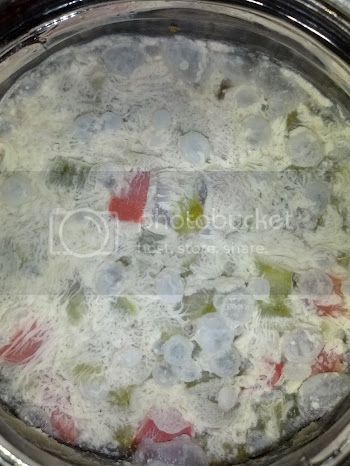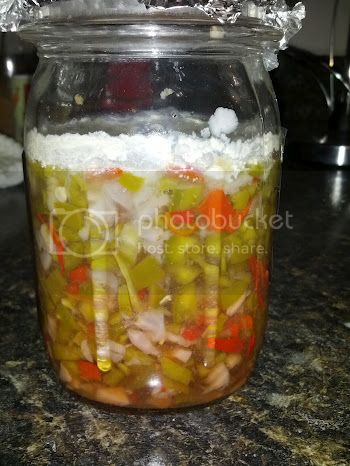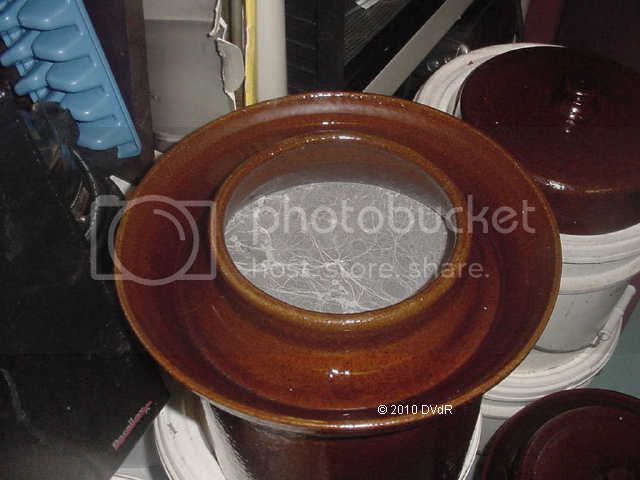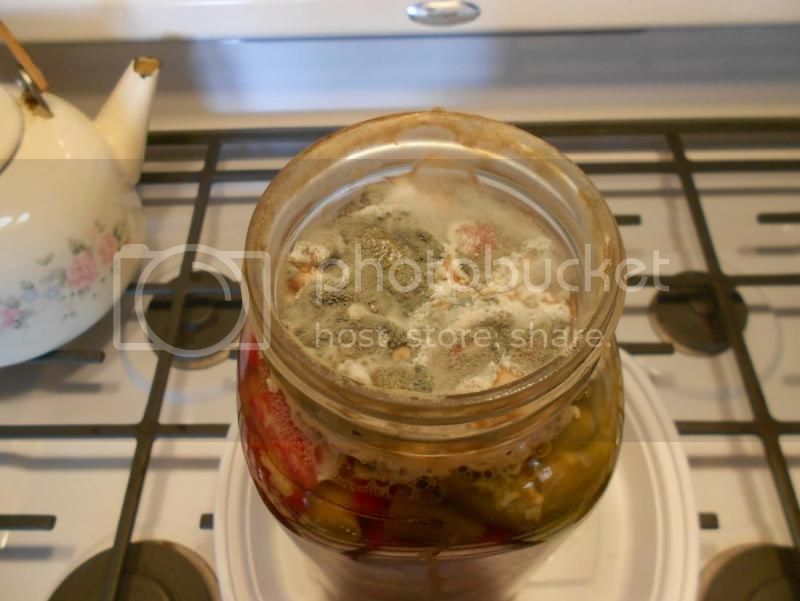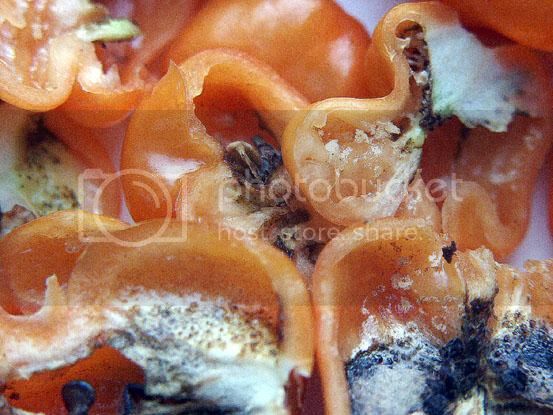If you’ve been fermenting vegetables for a while then you’ve probably faced a shock discovery. You’ve cut or shredded your vegetables, added salt or brine, submerged them in said brine, and then left them to ferment.
Then a day or more later you opened your jar to find, much to your horror, a white film of mold. Or, worse yet, a big hairy mold patch of varying colors.
You’re probably heartbroken, or at least disappointed. You may assume that all of that time and money you put into those vegetables you were fermenting was wasted.
Recognizing Mold
The first thing to know is that the white film that is often present in vegetable ferments is probably not mold, but something called kahm yeast.
Kahm yeast is a type of film that can readily be found in cultured and fermented foods. It is not harmful, although it may be unattractive or even smell a little odd. It should be removed from the ferment so it doesn’t impart a bad odor, but a little bit left in the jar won’t hurt the vegetables, and won’t hurt you.
Kahm yeast is likely to develop if a fermentation solution is insufficiently acid, especially when you start it, or if there is not enough salt in the brine. Kahm can also develop if the culturing temperature is too warm, or if the brew is over-exposed to oxygen. Poor hygiene can be another cause.
If kahm yeast develops in your ferment, skim it off the surface of the liquid. Discard any solid matter that has it. As usual, your senses are the test: if it smells and tastes okay, it probably is.
True molds are usually colorful and the deposits are round and often fuzzy or fluffy. They might even be white, but there is a distinctive difference between the smooth film that is kahm, and the puffy growth that is mold.
What to Do with a Moldy Ferment
If you opened your jar or vessel up to find a layer of mold on top, don’t panic. You may be able to easily dispose of this and have perfectly good fermented vegetables below the brine.
Lacto-fermentation is an anaerobic process meaning it must be in an oxygen-free environment for it to happen properly and fully. Any oxygen put into the mix can cause unwelcome microorganisms such as mold or yeasts.
So while your vegetables may be happily fermenting under the brine, the surface of the brine is still exposed to oxygen if you are using a jar or open-crock method of fermentation. This is common, though, and it was very common in times past to simply go to the cellar to check on the ferments, scrape any growth off the surface, and retrieve the fermented vegetables below.
Factors That May Contribute to Mold Growth
If you are experiencing a mold epidemic of sorts in your ferments then their maybe something more at play. You may want to investigate the following possibilities:
Fermentation Temperature
Ferments like sourdough and yogurt might prefer a warmer temperature of 80°F or 110°F, respectively, but vegetable ferments, in general, prefer a cooler temperature. This makes it especially difficult when you are attempting to preserve at the peak of the growing season, which is most likely the hottest time of the year.
Try to find a cool place to ferment your vegetables. A root cellar is ideal, and traditional, but a cool basement or garage is also helpful. Or just find the coolest place in your home. A temperature of 65° to 80°F is your best bet in avoiding mold.
Vegetable Submersion
Probably the most important factor in lactic acid fermentation is the submersion of the vegetables underneath the brine. Lacto-fermentation is an anaerobic process, meaning it requires a no-oxygen environment.
If you are experiencing mold problems check to make sure your ferment is under the brine. If it is not then you will need to weight the vegetables down with a clean rock or weight.
Salt Content
The purpose of salt in a lacto-ferment is to inhibit the growth of undesirable pathogens including molds and other microorganisms. Too much salt won’t allow lactic acid fermentation to occur fully, but too little salt can result in off flavors or mushy vegetables.
Likewise, too little salt will not preserve the food between the start of fermentation and when the lactic acid bacteria begin to proliferate and create an acidic environment on their own. This can lead to mold more readily taking hold of your ferment.
Introduction of Starter Culture
The introduction of an already established starter culture can help prevent unwelcome pathogens from taking hold of your ferment before the lactic acid bacteria have a chance to form.
You can use whey or a starter culture in these circumstances for a little extra insurance.
Bad Microorganisms Present on Your Vegetables
Finally, consider the vegetables themselves. Are they in a state of decay? Did you wait too long to get them fermented? Were they sprayed with chemicals that could interfere with the natural fermentation process?
If any of these are a factor then you may want to consider using only fresh, organic produce in your ferments if you have access to them.
In conclusion, mold occurring above the brine is a fairly normal part of fermentation, but anything out of the ordinary may be caused by a number of non-ideal situations for your ferments.
Source: http://www.culturesforhealth.com/vegetable-ferments-mold
Then a day or more later you opened your jar to find, much to your horror, a white film of mold. Or, worse yet, a big hairy mold patch of varying colors.
You’re probably heartbroken, or at least disappointed. You may assume that all of that time and money you put into those vegetables you were fermenting was wasted.
Recognizing Mold
The first thing to know is that the white film that is often present in vegetable ferments is probably not mold, but something called kahm yeast.
Kahm yeast is a type of film that can readily be found in cultured and fermented foods. It is not harmful, although it may be unattractive or even smell a little odd. It should be removed from the ferment so it doesn’t impart a bad odor, but a little bit left in the jar won’t hurt the vegetables, and won’t hurt you.
Kahm yeast is likely to develop if a fermentation solution is insufficiently acid, especially when you start it, or if there is not enough salt in the brine. Kahm can also develop if the culturing temperature is too warm, or if the brew is over-exposed to oxygen. Poor hygiene can be another cause.
If kahm yeast develops in your ferment, skim it off the surface of the liquid. Discard any solid matter that has it. As usual, your senses are the test: if it smells and tastes okay, it probably is.
True molds are usually colorful and the deposits are round and often fuzzy or fluffy. They might even be white, but there is a distinctive difference between the smooth film that is kahm, and the puffy growth that is mold.
What to Do with a Moldy Ferment
If you opened your jar or vessel up to find a layer of mold on top, don’t panic. You may be able to easily dispose of this and have perfectly good fermented vegetables below the brine.
Lacto-fermentation is an anaerobic process meaning it must be in an oxygen-free environment for it to happen properly and fully. Any oxygen put into the mix can cause unwelcome microorganisms such as mold or yeasts.
So while your vegetables may be happily fermenting under the brine, the surface of the brine is still exposed to oxygen if you are using a jar or open-crock method of fermentation. This is common, though, and it was very common in times past to simply go to the cellar to check on the ferments, scrape any growth off the surface, and retrieve the fermented vegetables below.
Factors That May Contribute to Mold Growth
If you are experiencing a mold epidemic of sorts in your ferments then their maybe something more at play. You may want to investigate the following possibilities:
Fermentation Temperature
Ferments like sourdough and yogurt might prefer a warmer temperature of 80°F or 110°F, respectively, but vegetable ferments, in general, prefer a cooler temperature. This makes it especially difficult when you are attempting to preserve at the peak of the growing season, which is most likely the hottest time of the year.
Try to find a cool place to ferment your vegetables. A root cellar is ideal, and traditional, but a cool basement or garage is also helpful. Or just find the coolest place in your home. A temperature of 65° to 80°F is your best bet in avoiding mold.
Vegetable Submersion
Probably the most important factor in lactic acid fermentation is the submersion of the vegetables underneath the brine. Lacto-fermentation is an anaerobic process, meaning it requires a no-oxygen environment.
If you are experiencing mold problems check to make sure your ferment is under the brine. If it is not then you will need to weight the vegetables down with a clean rock or weight.
Salt Content
The purpose of salt in a lacto-ferment is to inhibit the growth of undesirable pathogens including molds and other microorganisms. Too much salt won’t allow lactic acid fermentation to occur fully, but too little salt can result in off flavors or mushy vegetables.
Likewise, too little salt will not preserve the food between the start of fermentation and when the lactic acid bacteria begin to proliferate and create an acidic environment on their own. This can lead to mold more readily taking hold of your ferment.
Introduction of Starter Culture
The introduction of an already established starter culture can help prevent unwelcome pathogens from taking hold of your ferment before the lactic acid bacteria have a chance to form.
You can use whey or a starter culture in these circumstances for a little extra insurance.
Bad Microorganisms Present on Your Vegetables
Finally, consider the vegetables themselves. Are they in a state of decay? Did you wait too long to get them fermented? Were they sprayed with chemicals that could interfere with the natural fermentation process?
If any of these are a factor then you may want to consider using only fresh, organic produce in your ferments if you have access to them.
In conclusion, mold occurring above the brine is a fairly normal part of fermentation, but anything out of the ordinary may be caused by a number of non-ideal situations for your ferments.
Source: http://www.culturesforhealth.com/vegetable-ferments-mold

